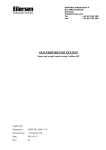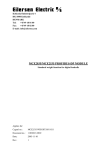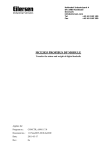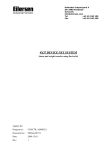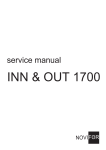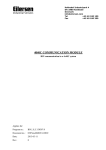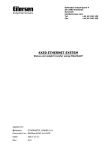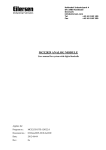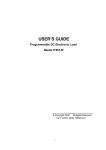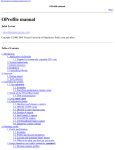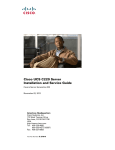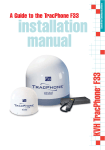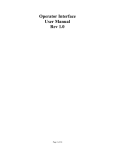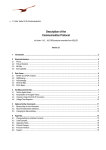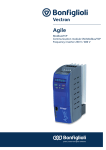Download 1103mu4X35-1 WEIGHT 4X35 Standard Manual UK PDF
Transcript
Kokkedal Industripark 4 DK-2980 Kokkedal Denmark [email protected] Tel +45 49 180 100 Fax +45 49 180 200 4X35 PROFIBUS-DP SYSTEM Standard weight function for digital loadcells Applies for: Cygnal no.: WEIGHT.051103.1 Document no.: 1103mu4X35-1.DOC Date: 2008-09-04 Rev.: 1 4X35: User manual 1) CONTENTS 1) CONTENTS.....................................................................................................................................2 2) INTRODUCTION ...........................................................................................................................3 2.1 Introduction.................................................................................................................................3 2.2 Profibus-DP specification ...........................................................................................................3 2.3 Update times ...............................................................................................................................3 3) DATA EXCHANGE .......................................................................................................................4 3.1 Profibus-DP communication using PPO.....................................................................................4 3.2 PCV Description .........................................................................................................................5 3.3 PCD Description .........................................................................................................................7 4) PARAMETER LIST......................................................................................................................10 4.1 Parameter list ............................................................................................................................10 5) PARAMETER DESCRIPTION ....................................................................................................12 5.1 Parameter description................................................................................................................12 6) DATA PROCESSING ...................................................................................................................15 6.1 Zeroing procedure.....................................................................................................................15 6.2 Calibration procedure................................................................................................................15 7) INSTALATION OF SYSTEM ......................................................................................................17 7.1 Checklist during installation .....................................................................................................17 8) HARDWARE DESCRIPTION .....................................................................................................19 8.1 4X35 overview..........................................................................................................................19 8.2 4X35 front panel description ....................................................................................................19 8.2.1 Connection of power ......................................................................................................19 8.2.2 Connection of loadcells..................................................................................................20 8.2.3 Profibus-DP connector ...................................................................................................20 8.2.4 SW1 settings...................................................................................................................20 8.2.5 SWP settings ..................................................................................................................20 8.2.6 Light Emitting Diodes (LEDs).......................................................................................21 8.3 Hardware Selftest......................................................................................................................21 9) APPENDIX....................................................................................................................................22 9.1 4035 Profibus-DP module.........................................................................................................22 9.1.1 SW3 settings...................................................................................................................22 9.1.2 Jumper settings...............................................................................................................23 9.1.3 JTAG connector .............................................................................................................23 9.2 4040 communication module....................................................................................................23 9.3 Status codes...............................................................................................................................24 9.4 Data formats..............................................................................................................................25 9.4.1 Unsigned integer format (16 bit)....................................................................................25 9.4.2 Signed integer format (32 bit) ........................................................................................25 9.4.3 IEEE754 floating point format (32 bit) ..........................................................................26 Version: 2008-09-04, rev.: 1 Page: 2 4X35: User manual 2) INTRODUCTION 2.1 Introduction This document describes the use of a 4X35 Profibus-DP system unit from Eilersen Electric. The 4X35 system unit consists internally of a 4035 Profibus-DP module (with the program listed on the front page) and a 4040 communication module. The 4X35 system unit is connected to X loadcells (1-4). With the program specified on the front page, the 4X35 Profibus-DP unit can act as a single system weight for up to 4 loadcells. It is possible to connect the 4X35 Profibus-DP unit to a Profibus-DP network, where it will act as a slave. It will then be possible from the Profibus-DP master to read status, read system weight and perform commands such as zeroing and calibration. Exchange of data between master and slave takes place as described in the following. 2.2 Profibus-DP specification The Profibus-DP unit confirms to the following Profibus-DP specifications: Protocol: Communications form: Module type: Baud rates [kbit/sec]: Profibus address: Profibus connection: Profibus-DP RS485 Slave 9.6, 19.2, 93.75, 187.5, 500, 1500, 3000, 6000, 12000 0-127 9-pin sub-D (female) connector 2.3 Update times The 4X35 Profibus-DP system unit samples the loadcell signals over a period of 200 mS. The hereby found loadcell signals are used in the Profibus-DP communication until new signals are achieved when the next sample period expires. Update times across the Profibus-DP communication depends on the specific Profibus-DP configuration (selected baudrate, number of slaves, scan times etc.). Version: 2008-09-04, rev.: 1 Page: 3 4X35: User manual 3) DATA EXCHANGE 3.1 Profibus-DP communication using PPO Profibus-DP communication with the 4X35 Profibus-DP unit uses a so called 'parameterprocess data object' (PPO) consisting of 14 bytes. This object is used during reception as well as during transmission of data. The structure of this telegram is as follows: PCV PCD PCA 1 IND 2 3 PVA 4 5 CTW STW 6 7 8 9 MRV MAV 10 11 12 13 14 Byte 14 Byte 1 The telegram is made up of two blocks; a PCV part (the first 8 bytes) and a PCD part (the last 6 bytes). The two blocks are made up as follows: PCV (Parameter-Characteristic-Value) PCA (Bytes 1-2): Parameter Characteristics IND (Bytes 3-4): Not used (reserved for future use) PVA (Bytes 5-8): Parameter value PCD (Process Data) CTW (Bytes 9-10) (Master to Slave): STW (Bytes 9-10) (Slave to Master): MRV (Bytes 11-14) (Master to Slave): MAV (Bytes 11-14) (Slave to Master): Control Word Status Word Main Reference Value Main Actual Value In the following the meaning of the individual blocks in the telegram is described in detail. The byte order (MSB/LSB first) for the individual parts is selected using jumper JU8, and upon factory delivery it is default set to MSB byte first. The data format of the MAV part and parameters in the PVA part is 32 bit signed integer format (2’s complement). It is possible however, by using of jumper JU7 to change so that the MAV part and certain parameters in the PVA part are transferred in IEEE754 floating point format. During transmission/reception of data consisting of several bytes (for example the MAV) it is up to the master (the PLC) to provide for consistent (belonging together) data. Version: 2008-09-04, rev.: 1 Page: 4 4X35: User manual 3.2 PCV Description The PCV part of the telegram is as mentioned made up of a PCA part, an IND part and a PVA part. As mentioned the IND part is not used, but the functionality of the other two parts of the PCV is described here. PCA handling The PCA part contains a RC part for 'request' and 'response' indication, and a PNU part for indication of parameter number. This is shown in the figure of the PCA block below. Bit 15 15 Bit 0 14 13 12 11 RC RC: TBD: PNU: 10 9 8 7 6 TBD 5 4 3 2 1 0 PNU Request/Response Characteristics Not used Parameter number (Values: 0..15) (Reserved for future use.) (Values: 0..999) RC - Request/Response Characteristics The RC part is used by the master to tell the slave (the weight) what 'requests' are wanted. Similarly the RC part is used by the slave to tell ('response') the master the status/results of the received 'requests'. The RC part further informs which other parts of the PCV (IND and PVA) are used. The contents of the RC part has the following function during request: REQUEST FUNCTION 0 No request 1 Request parameter value 2 Change parameter value (2 bytes) 3 Change parameter value (4 bytes) 4-15 Version: 2008-09-04, rev.: 1 Reserved for future use Page: 5 4X35: User manual The contents of the RC part has the following function during response: RESPONSE FUNCTION 0 No response 1 Transfer parameter value (2 bytes) 2 Transfer parameter value (4 bytes) 3 Request refused (incl. Error#, see later) 4 Can not be serviced by PCV interface 5-15 Reserved for future use PNU - Parameter number Bit 10 to Bit 0 in the PCA part indicates the parameter number of the parameter to be read/changed. The individual parameters and their function is explained later. PVA handling The PVA part contains 4 bytes for reception and transmission of parameter values. The PVA part will transfer '2 byte' parameters in either bytes 7-8 (MSB first selected) or bytes 5-6 (LSB first selected). ‘4 byte’ parameters are transferred in bytes 5-8. If the slave (the weight) refuses a request from the master the RC part will assume the value 3 (see above) and the actual error code will be transferred in the PVA element. The following error indications are possible: ERROR# Version: 2008-09-04, rev.: 1 CAUSE 0 Illegal PNU 1 Reserved for future use 2 Upper or lower limit is exceeded Page: 6 4X35: User manual 3.3 PCD Description As mentioned the PCD part of the telegram is made up of a CTW/STW part and a MRV/MAV part. The functionality of the PCD parts is described here. Note that the PCD part (the last 6 bytes) always transfers these data independent of the contents of the PCV part (the first 8 bytes). CTW handling During communication from the master to the slave (the weight) the first two bytes in the PCD part is used as a Control Word (CTW). By use of the Control Word (CTW) it is possible to tell the slave (the weight) how it should react, as different commands can be transferred to the weight. The bit’s in CTW have the following function: BIT-NO FUNCTION 0 Reserved for future use 1 Zero system. 2 Calibrate corner. 3 Calibrate system. 4 Reset calibration. 5-14 15 Reserved for future use Clear error in Error-register. If the Zero system bit is activated all loadcells and thereby the calculated system weight will be zeroed. This should only be done with an empty weighing arrangement. If the Calibrate corner bit is activated the loadcell specified by the Corner-register will be calibrated to the weight indicated by the Calibration load for corner/system register. If the Calibrate system bit is activated the system weight will be calibrated to the weight indicated by the Calibration load for corner/system register. Note that the individual calibration of the loadcells remains unchanged. If the Reset calibration bit is activated all calibration factors (system and all loadcell factors) will be set to their standard value of 32768. If the Clear error in Error-register bit is activated any error in the Error-register will be cleared. Version: 2008-09-04, rev.: 1 Page: 7 4X35: User manual STW handling During communication from slave (the weight) to the master the first two bytes in the PCD part are used as a Status Word (STW). By reading the Status Word (STW) it is possible for the master to achieve information on the status of the slave (the weight). The functionality of the individual bits in the Status Word (STW) is described below: BIT-NO FUNCTION 0 1-3 LC-error. Reserved for future use 4 Zeroing OK. 5 Zeroing not possible. 6 Calibration OK. 7 Calibration not possible. 8 Reset Calibration OK. 9 Clear Error OK. 10-14 15 Reserved for future use Error detected. If the LC-error bit is ON one or more loadcells detected at power up are in an error state. The actual error can be read in the Status for loadcell X register for the individual loadcell. If the Zeroing OK bit is ON the last zero request has been performed. Note that the bit is cleared during the zero process and after the Zero system bit is cleared again. If the Zero not possible bit is ON the last zero request has not been performed. The reason for this can be read in the Zeroing-register. Note that the bit is cleared during the zero process and after the Zero system bit is cleared again. If the Calibration OK bit is ON the last calibration request has been performed. Note that the bit is cleared during the calibration process and after both the Calibrate corner and Calibrate system bits are cleared again. If the Calibration not possible bit is ON the last calibration request has not been performed. The reason for this can be read in the Calibration-register. Note that the bit is cleared during the calibration process and after both the Calibrate corner and Calibrate system bits are cleared again. If the Reset calibration OK bit is ON the last reset calibration request has been performed. Note that the bit is cleared during the process and after the Reset calibration bit is cleared again. Version: 2008-09-04, rev.: 1 Page: 8 4X35: User manual If the Clear error OK bit is ON the last clear error request has been performed. Note that the bit is cleared during the process and after the Clear error in Error-register bit is cleared again. If the Error detected bit is ON the system has detected an error. The actual error can be found in the Error-register. MRV handling During communication from the master to the slave (the weight) the four last bytes in the PCD part are used as a Main Reference Value (MRV); a setpoint. The Main Reference Value (MRV) has no function in this program. MAV handling During communication from the slave (the weight) to the master the four last bytes in the PCD part are used as a Main Actual Value (MAV); the actual value. The Main Actual Value (MAV) is used to transfer the actual gross weight of the system. The gross weight must be scaled in accordance to the Exponent for MAV parameter (Par.No.=15) if Gram mode has not been selected using jumper JU1. Default factory setting is that Gram mode is not selected. Note that the MAV part may be transferred in 32 bit signed integer format (default) or in IEEE754 floating point format depending on the actual jumper setting. Version: 2008-09-04, rev.: 1 Page: 9 4X35: User manual 4) PARAMETER LIST 4.1 Parameter list A part from main values (MRV/MAV) and control/status word (CTW/STW), which are transferred at all times using the PCD part, it is possible to access the individual parameters one at a time using the PCV part. The following parameters can be read/updated using the PCV part: NO TYPE PARAMETER 0 2R 1 2 RW 2-6 2 7 2R Error-register Bit register for indication of detected errors. 8 2R Zeroing-register Bit register for indication of errors during zeroing. 9 2R Calibration-register Bit register for indication of errors during calibration. 10-14 2 15 2R 16 - 19 (20 - 31) 32 - 35 (36 – 47) 48 - 51 (52 – 63) 64 - 67 (68 – 79) 80* - 83* (84* - 95*) 96* - 99* (100* - 111*) 112* 2R (2 R) 2R (2 R) 4R (4 R) 4R (4 R) 4 RW (4 RW) 4 RW (4 RW) 4 RW 113 4 RW 114-127 4 Version: 2008-09-04, rev.: 1 LC-register Bit register for indication of connected loadcells detected during power-up. Corner-register Indicates corner (loadcell number) to be corner calibrated. Reserved for future use Reserved for future use Exponent for MAV Exponent for loadcell 0 - 3 (Exponent for loadcell 4 - 15) Status for loadcell 0 - 3 (Status for loadcell 4 – 15) Actual gross weight for loadcell 0 - 3 (Actual gross weight for loadcell 4 – 15) Actual signal for loadcell 0 - 3 (Actual signal for loadcell 4 – 15) Actual zero for loadcell 0 - 3 (Actual zero for loadcell 4 – 15) Corner calibration factor for loadcell 0 - 3 (Corner calibration factor for loadcell 4 – 15) Calibration factor for system Calibration load for corner/system Reserved for future use Page: 10 4X35: User manual Note that NO indicates the parameter number for the parameter in question. Note that TYPE indicates the length of the parameter in question (2 = 2 bytes and 4 = 4 bytes). In addition after the length it is indicated whether its a read and write register (RW = ReadWrite) or its a read only register (R = Read). Note that data values are transferred as 2 complement signed values. Note that a * after the parameter number indicates that the parameter in question is stored in the SEEPROM of the module, why this parameter can be remembered after power has been disconnected. Please note that no zeroing or calibration is performed at power-up. Version: 2008-09-04, rev.: 1 Page: 11 4X35: User manual 5) PARAMETER DESCRIPTION 5.1 Parameter description The individual parameters have the following functions: LC-register is a bit register for indication of connected loadcells detected at power-up. Hence bit 0-15 will be ON, if the corresponding loadcell was detected during power-up.. Corner-register indicates which corner (loadcell number) that has to be corner calibrated. The loadcell number corresponds to the number on the front panel minus one (i.e. 0-3). Values in the interval 4-65535 indicate that the calibration corner is not selected. Error-register is a bit register for indication of detected errors. The individual bits have the following function: BIT-NO FUNCTION 0 A checksum error for storage of zero and calibration in the SEEPROM of the module was detected during power-up. 1 A calibration factor was out of range during power-up (or scale is not calibrated). 2 A zero was invalid during power-up (or scale has not been zeroed). 3 Inconsistency between number of detected loadcells during power on and the number of loadcells indicated using Sw3.1-Sw3.4. 4-15 Reserved for future use Zero-register is a bit register for indication of errors during zero. The individual bits have the following function: BIT-NO 0 1-15 Version: 2008-09-04, rev.: 1 FUNCTION LC-error during zero Check status for the individual loadcells. Reserved for future use Page: 12 4X35: User manual Calibration-register is a bit register for indication of errors during calibration. The individual bits have the following function: BIT-NO FUNCTION 0 LC-error during calibration Check status for the individual loadcells. 1 Calibration load not selected/valid Check that a valid calibration load has been selected. 2 Calibration corner not selected/valid Check that a valid calibration corner has been selected. 3 Calibration range exceeded It was not possible to calibrate the system within the valid calibration range. Check that nothing is affecting the weighing arrangement mechanically. Check that the value in the Calibration load for corner/system register corresponds to the actual load. 4 Gross weight was negative during calibration Check the gross weight and whether it shows zero without any load. 5-15 Reserved for future use Exponent for MAV is a register containing the exponent for the MAV. If Gram mode has not been selected using jumper JU1, the transferred gross weight has to be compared with this exponent. It indicates the "resolution” of the MAV (gross weight) as described under Exponent for loadcell X. The exponent corresponds to the smallest loadcell exponent. Exponent for loadcell X is a register containing the exponent of loadcell X. The transferred weighing result has to be compared with the exponent for the loadcells. The exponent is a fixed value (2 complement) for a given loadcell, and it indicates the "resolution" of the loadcell (weighing result) as follows: Exponent [Decimal] Exponent [Hexadecimal] Conversion factor to gram SI unit -3 -2 -1 0 1 2 3 4 5 6 0xFFFD 0xFFFE 0xFFFF 0x0000 0x0001 0x0002 0x0003 0x0004 0x0005 0x0006 *10-3 *10-2 *10-1 *100 *101 *102 *103 *104 *105 *106 mg Version: 2008-09-04, rev.: 1 gram Kg ton Page: 13 4X35: User manual Status for loadcell X is a register containing the actual status for loadcell X. The meaning of the status code can be found in the STATUS CODES chapter. Actual gross weight for loadcell X contains the actual gross weight for loadcell X. The gross weight is the actual load signal for the loadcell adjusted by zero and calibration factor. Note that the value is a value averaged over 200 ms. Actual signal for loadcell X contains the actual signal for loadcell X. The actual signal is the actual load signal for the loadcell without any adjustment fir zero and calibration factor. Note that the value is a value averaged over 200 ms. Actual zero for loadcell X contains the actual zero value for loadcell X. The value is determined during zero from Actual signal for loadcell X. Corner calibration factor for loadcell X contains the calibration factor for loadcell X. The value is determined during calibration of corner X, and lies in the interval 24576-40960 with 32768 as center value (standard calibration factor corresponding to no calibration). Calibration factor for system contains the system calibration factor. The value is determined during calibration of the system, and lies in the interval 24576-40960 with 32768 as center value (standard calibration factor corresponding to no calibration). Calibration load for corner/system must contain the load used during calibration of the system or corner. Note that this parameter is always transferred in the same format as the MAV. The format may vary depending on the actual jumper settings (MSB/LSB first, SI32/IEEE754 format and Standard/Gram mode). Version: 2008-09-04, rev.: 1 Page: 14 4X35: User manual 6) DATA PROCESSING 6.1 Zeroing procedure Zeroing of the system (all loadcells) should be done using the following procedure: 1) The weighing arrangement should be empty and clean. 2) The Zero system bit in the Control Word is activated. Note that zeroing is only done on the 0-1 transition. 3) By reading the Zeroing OK and the Zeroing not possible bits it is possible to read the result of the desired zeroing. If zeroing is not possible the reason can be read in the Zeroing-register. It is always possible to read the achieved or used zero by reading from the parameter numbers where the loadcell zeroes are stored. If in possession of a zero from a previous zeroing it is possible to insert this zero by writing to the parameter numbers where the loadcell zeroes are stored. Note that no zeroing is performed at power-on. 6.2 Calibration procedure Fine calibration of the system should be performed using the following procedure: 1) Check that the weighing arrangement is empty, and that the gross weight is zero. Zero if necessary. 2) Place a known load on the weighing arrangement. 3) Transfer the value for the known load to the Calibration load for corner/system register. 4) The Calibrate system bit in the Control Word is activated. Note that calibration is only done on the 0-1 transition. 5) By reading the Calibration OK and the Calibration not possible bits it is possible to read the result of the desired calibration. If calibration is not possible the reason can be read in the Calibration-register. 6) If Calibration OK is indicated the transferred gross weight should now match the used calibration load and the calibration factor has been updated. If Calibration not possible is indicated the system calibration factor is not changed. Version: 2008-09-04, rev.: 1 Page: 15 4X35: User manual If a corner calibration of the weighing arrangement is desired, the above listed procedure can still be used as the following is taken into account: 1) Corner calibration should be performed prior to system calibration. During corner calibration the Calibration factor for system should be set to its standard value of 32768. 2) Corner calibration is done one corner at a time, where the above listed procedure is used for each corner. 3) The actual calibration corner is selected in the Corner-register prior to start of corner calibration. The corner number corresponds to the loadcell number (on the front panel of the system unit) minus one (i.e. 0-3). If in doubt the loadcell number can be verified by finding the Actual gross weight for loadcell X, which gives a corresponding signal change when a load is placed/removed directly above the actual loadcell. 4) It is the Calibrate corner bit in the Control Word (CTW), that has to be activated and not the Calibrate system bit. 5) The used calibration load must be placed directly above the actual loadcell, so that it is this loadcell that absorbs the "entire" load. 6) It is not the system gross weight, that has to be observed but the Actual gross weight for loadcell X. If the other loadcells are completely unloaded, this value should correspond with the system gross weight. 7) Every corner calibration only changes the calibration factor for the corresponding corner. The other corner and system calibration factors remain unchanged. It is always possible to read the achieved or used calibration factors by reading from the parameter numbers where the calibration factors are stored. If in possession of calibration factors from a previous calibration, it is possible to insert these by writing to the parameter numbers where the calibration factors are stored. Note that no calibration is performed at power-on. Version: 2008-09-04, rev.: 1 Page: 16 4X35: User manual 7) INSTALATION OF SYSTEM 7.1 Checklist during installation During installation of the system the following should be checked: 1) If necessary the Profibus-DP master should be configured to communicate with the 4X35 ProfibusDP system unit using the supplied GSD file. 2) The loadcells are mounted mechanically and connected to BNC connectors in the front panel of the 4X35 system unit. 3) The 4X35 Profibus-DP system unit is connected to the Profibus-DP network using the Profibus-DP connector in the front panel of the 4X35 system unit. If necessary a possible termination of the Profibus-DP network is made at this Profibus-DP slave. 4) Use SW1 in the front panel of the 4X35 system unit to select any features specified in the separate manual for the 4040 communication module. 5) Use SWP.2-SWP.8 in the front panel of the 4X35 system unit to select the communication address of the 4X35 Profibus-DP system unit. 6) Power (24VDC) is applied at the 2 pole power connectors in the front panel of the 4X35 system unit as described in the hardware section, and the Profibus-DP communication is started. 7) Verify that the PBE lamp (red) is NOT lit, and that the DES lamp (yellow) and the RTS lamp (yellow) are lit/flashing. 8) Verify that the TxLC lamp (yellow) is lit (turns on after approx. 5 seconds). 9) Verify that the two TxBB lamps (green) are lit (both lit after 10 seconds). 10) Verify that NONE of the 1, 2, 3 or 4 lamps (red) are lit. 11) Verify that the 4X35 Profibus-DP system unit has found the correct loadcells (Par.No.=0), and that no loadcell error is indicated in the Status Word (STW). 12) Reset all calibration factors by using the Reset Calibration bit in the Control Word (CTW). 13) Zero the system weight with empty weighing arrangement by using the “Zeroing procedure” described earlier. 14) Verify that every loadcell gives a signal (Par.No.=48-63) by placing a load directly above each loadcell one after the other (possibly with a known load). 15) Place a known load on the weighing arrangement, and check that the system weight (MAV) corresponds to the load. Does the master take the exponent (scaling) into account if Gram mode has not been selected? 16) Zero the system weight with empty weighing arrangement by using the “Zeroing procedure” described earlier. 17) Place a known load (as close to maximum load as possible) on the weighing arrangement. 18) If the system weight deviates to much from the actual load a fine calibration of the system is made using the “Calibration procedure” described earlier. Version: 2008-09-04, rev.: 1 Page: 17 4X35: User manual The system is now installed and a final check is made before the system is taken into usage. Possibly make a note of all zeroes (Par.No.=80-95) and calibration factors (Par.No,=96-112) for later use. Note that in the above checklist no consideration has been made on which functions are implemented on the Profibus-DP master. Version: 2008-09-04, rev.: 1 Page: 18 4X35: User manual 8) HARDWARE DESCRIPTION 8.1 4X35 overview The following figure is an overview of a 4X35 system unit with 4 loadcell connections (i.e. a 4435 system unit): 4435A J3 ATEX J2 0 24V 24V 0 1 1 PROFIBUS SW1 4 2 ON 3 8 SWP 1 DES RTS PBE TxBB D1 D2 4 ON TxLC TxBB 1 2 3 4 8.2 4X35 front panel description This chapter describes the connections, DIP-switch settings and lamp indications that are available on the front panel of the 4X35 system unit. 8.2.1 Connection of power The 4X35 system unit is powered by applying +24VDC on the green two pole connectors (J2 and J3) as specified on the front panel of the 4X35 system unit. This powers the entire 4X35 system unit including the loadcells. NOTE: If the loadcells are to be placed inside an EX area, then the 4X35 system unit itself MUST be placed outside the EX area, and the 4X35 system unit MUST be supplied as follows: 1) The 2 pole connector (J3), located to the right above the 4 pole DIP-switch block, MUST be powered by a 4051A power supply (+24VDC ATEX approved) from Eilersen Electric. 2) The 2 pole connector (J2), located to the left above the 9 pole Sub-D connector (PROFIBUS), MUST be powered by a separate +24VDC, that has NO connection to the ATEX approved +24VDC from the above mentioned 4051A power supply. Version: 2008-09-04, rev.: 1 Page: 19 4X35: User manual 8.2.2 Connection of loadcells The loadcells must be connected to the available BNC connectors in the front panel of the 4X35 system unit. The loadcells are connected starting with the connector marked 1 and continuing onwards in rising order. Thus if three loadcells are to be connected, they should be connected to the BNC connectors marked 1, 2 and 3. 8.2.3 Profibus-DP connector The front panel of the 4X35 system unit is equipped with a nine pole female sub-D connector with a standard Profibus-DP interface. This allows for direct connection to a ProfibusDP network using standard Profibus-DP connectors. Termination of the Profibus should take place in the sub-D connector (male) of the cable. The specific terminals in the connector have the following function: TERMINALS 1 2 3 4 5 6 7 8 9 FUNCTION Not used Not used RS485-A (positive line) (Siemens designation: B line) Request to Send (RTS) 0 VDC (Gnd) +5VDC (Vout) Not used RS485-B (negative line) (Siemens designation: A line) Not used Note that some companies use different designations for the RS485-A and the RS485-B lines. Therefore the polarity of the lines has been listed. 8.2.4 SW1 settings The front panel of the 4X35 system unit is equipped with a 4 pole DIP switch block named SW1. These switches are mounted on the 4040 communication module, and their functionality is described in the separate manual for the 4040 communication module. They are typically used for filter selection. 8.2.5 SWP settings The front panel of the 4X35 system unit is equipped with a 8 pole DIP switch block named SWP. These switches allow setting of the Profibus-DP communication address of the 4X35 Profibus-DP system unit. This DIP switch block has the following function: SWITCH SWP.1 SWP.2-SWP.8 FUNCTION Reserved for future use Selection of Profibus-DP communication address The address is selected as the DIP-switches are binary coded, so SWP.2 is MSB and SWP.8 is LSB. Note that these switches are only read during power on. Version: 2008-09-04, rev.: 1 Page: 20 4X35: User manual 8.2.6 Light Emitting Diodes (LEDs) The front panel of the 4X35 system unit is equipped with a number of status lamps (light emitting diodes). These have the following functionality: LED FUNCTION DES Data Exchange State (Yellow) RTS Exchange of data between 4X35 Profibus-DP slave and master. RtS signal (SPC3) (Yellow) The 4X35 Profibus-DP system unit sends to the master. PBE Profibus Error (when initializing the SPC3) (Red) The 4X35 Profibus-DP system unit was not initialized correctly. TxBB (Left) 4035 communication with 4040 module (internal) (Green) D1 4035 Profibus-DP module is transmitting to 4040 module. Reserved for future use (Green) D2 Reserved for future use (Green) TxLC (Yellow) TxBB (Right) (Green) 1 (Red) 2 (Red) 3 (Red) 4 (Red) 4040 communication with loadcells Please refer to the separate 4040 manual for further information. 4040 communication with 4035 Profibus-DP module (internal) Please refer to the separate 4040 manual for further information. Status for loadcell 1 Bad connection, loadcell not ready or other error detected. Status for loadcell 2 Bad connection, loadcell not ready or other error detected. Status for loadcell 3 Bad connection, loadcell not ready or other error detected. Status for loadcell 4 Bad connection, loadcell not ready or other error detected. 8.3 Hardware Selftest During power-on the 4X35 Profibus-DP system unit will perform a hardware selftest. The test will cause the light emitting diodes D1, D2 and PBE to turn on and off shortly, one at a time. Version: 2008-09-04, rev.: 1 Page: 21 4X35: User manual 9) APPENDIX 9.1 4035 Profibus-DP module This chapter describes possible connections, DIP-switch settings and jumper settings that are available internally on the 4035 Profibus-DP module. These will normally be set from Eilersen Electric and should only be changed in special situations. 9.1.1 SW3 settings The 4035 Profibus-DP module is internally equipped with a 4 pole DIP switch block named SW3. This DIP switch block has the following function: SWITCH Sw3.1-Sw3.4 FUNCTION Expected number of loadcells The expected number of loadcells is set as indicated below. Note that these switches are only read at power-up. where the number of loadcells is indicated using Sw3.1-Sw3.4 as follows: Sw3.1 Sw3.2 Sw3.3 Sw3.4 Number of loadcells OFF OFF OFF OFF OFF OFF OFF OFF ON ON ON ON ON ON ON ON OFF OFF OFF OFF ON ON ON ON OFF OFF OFF OFF ON ON ON ON OFF OFF ON ON OFF OFF ON ON OFF OFF ON ON OFF OFF ON ON OFF ON OFF ON OFF ON OFF ON OFF ON OFF ON OFF ON OFF ON 16 1 2 3 4 5 6 7 8 9 10 11 12 13 14 15 Version: 2008-09-04, rev.: 1 Page: 22 4X35: User manual 9.1.2 Jumper settings The 4035 Profibus-DP module is internally equipped with 7 jumpers. These jumpers have these functions: JUMPER JU1 FUNCTION Selection of (Standard mode) / (Gram mode) The jumper determines if certain weight indications in the telegram are in standard format (must be scaled according to the exponent) or directly in grams. OFF: Standard mode (normal setting from factory) ON: Gram mode JU2-JU4 Reserved for future use (termination) (normal default factory setting is OFF) JU6 Reserved for future use (normal default factory setting is OFF) JU7 Selection of (32 Bit Signed Integer) / (IEEE754) data format The jumper determines if the weight indications in the telegram are in 32 bit signed integer or in IEEE754 floating point format. OFF: 32 bit signed integer format (normal setting from factory) ON: IEEE754 floating point format JU8 Selection of LSB/MSB data format The jumper determines the byte order in which data are transmitted/received. OFF: LSB first ON: MSB first (normal setting from factory) 9.1.3 JTAG connector The 4035 Profibus-DP module is internally equipped with a JTAG connector. The connector (J5) is used exclusively by Eilersen Electric A/S for download of new software. 9.2 4040 communication module For information on jumper settings, DIP-switch settings, LED status lamps etc. on the 4040 communication module that is not covered in the above, please refer to the separate documentation, that describes the 4040 communication module and its specific software. Version: 2008-09-04, rev.: 1 Page: 23 4X35: User manual 9.3 Status codes Status codes for the connected loadcells are shown as a 4 digit hex number. If more than one error condition is present the error codes are OR’ed together. Note that the table below is a list of error codes that normally can appear, but that other error codes are possible. In such a case please refer to the documentation for the actual used 4040 program. CODE (Hex) CAUSE 0001 0002 0004 0008 0010 Reserved for future use Reserved for future use Reserved for future use Reserved for future use 0020 New loadcell detected or loadcells swapped Power the system off and back on. Then verify that all parameters are acceptable. 0040 No answer from loadcell Bad connection between loadcell and loadcell module? Bad connection between loadcell module and communication module? 0080 No answer from loadcell Bad connection between communication module and Beebus master? Reserved for future use Reserved for future use Reserved for future use 0100 0200 0400 0800 1000 2000 4000 8000 Power failure Supply voltage to loadcells is to low. No loadcell answer Bad connection between loadcell and loadcell module? Bad connection between loadcell module and communication module? Bad connection between communication module and Beebus master? Bad setting of DIP switches on loadcell or communication module? Reserved for future use Reserved for future use Reserved for future use Reserved for future use Version: 2008-09-04, rev.: 1 Page: 24 4X35: User manual 9.4 Data formats The Profibus-DP communication can transfer data in the following three data formats. If necessary please refer to other literature for further information on these formats. 9.4.1 Unsigned integer format (16 bit) The following are examples of decimal numbers represented on 16 bit unsigned integer format: Decimal 0 1 2 200 2000 20000 Hexadecimal 0x0000 0x0001 0x0002 0x00C8 0x07D0 0x4E20 Binary (MSB first) 00000000 00000000 00000000 00000000 00000111 01001110 00000000 00000001 00000010 11001000 11010000 00100000 9.4.2 Signed integer format (32 bit) The following are examples of decimal numbers represented on 32 bit signed integer format: Decimal Hexadecimal -20000000 -2000000 -200000 -20000 -2000 -200 -2 -1 0 1 2 200 2000 20000 200000 2000000 20000000 0xFECED300 0xFFE17B80 0xFFFCF2C0 0xFFFFB1E0 0xFFFFF830 0xFFFFFF38 0xFFFFFFFE 0xFFFFFFFF 0x00000000 0x00000001 0x00000002 0x000000C8 0x000007D0 0x00004E20 0x00030D40 0x001E8480 0x01312D00 Version: 2008-09-04, rev.: 1 Binary (MSB first) 11111110 11111111 11111111 11111111 11111111 11111111 11111111 11111111 00000000 00000000 00000000 00000000 00000000 00000000 00000000 00000000 00000001 11001110 11100001 11111100 11111111 11111111 11111111 11111111 11111111 00000000 00000000 00000000 00000000 00000000 00000000 00000011 00011110 00110001 11010011 01111011 11110010 10110001 11111000 11111111 11111111 11111111 00000000 00000000 00000000 00000000 00000111 01001110 00001101 10000100 00101101 00000000 10000000 11000000 11100000 00110000 00111000 11111110 11111111 00000000 00000001 00000010 11001000 11010000 00100000 01000000 10000000 00000000 Page: 25 4X35: User manual 9.4.3 IEEE754 floating point format (32 bit) Representation of data on IEEE754 floating point format is done as follows: Byte1 Byte2 Byte3 Byte4 bit7 bit6 bit0 bit7 bit6 bit0 bit7 bit0 bit7 bit0 7 1 0 -1 -7 -8 -15 -16 S 2 …..…. 2 2 2 ……... 2 2 ………….... 2 2 ………..…. 2-23 Sign Exponent Mantissa Mantissa Mantissa Formula: Value = (-1)S * 2(exponent-127) * (I+Mantissa) Example: Byte1 0100 0000 Byte2 1111 0000 Byte3 0000 0000 Byte4 0000 0000 Value = (-1)0 * 2(129-127) * (1 + 2-1 + 2-2 + 2-3) = 7.5 Please note that if transfer of MSB first has been selected (default setting), the byte with the “sign” will come first in the weight indications, and if LSB first has been selected the byte with the “sign” will come last in the weight indications. Version: 2008-09-04, rev.: 1 Page: 26


























